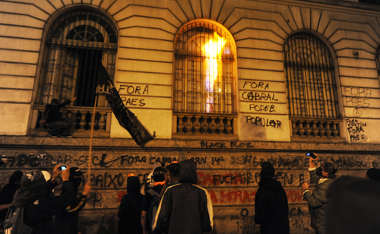the calls black blocks became a common topic in the press, social networks and conversation circles in Brazil after the outbreak of demonstrations against the increase in public transport fares in several cities of the Brazil. The death of Santiago Andrade, cameraman for the Bandeirantes TV network, on February 10, 2014, made the event even more intense. debate, as evidence indicates that his death was due to a firecracker launched in a demonstration on 06 of February. The press has called the suspects black bloc participants, even though they are dressed in gray rather than black.
The purpose of the text is not to debate this fact that occurred in Rio de Janeiro, but rather to briefly expose the black bloc history and the development of this urban guerrilla tactic used in street demonstrations.
At origins of black bloc (black block, in English) date back to the Federal Republic of Germany (ocidental Germany) in the early 1980s. It was the West German press that coined the term Schwarzer Block
to refer to groups of people who were organizing to face police repression. Such repression was unleashed as a result of the struggle of German autonomist groups (Marxists not linked to the party and union bureaucracies) against the construction of nuclear power plants, for the defense of their occupations (squats) from abandoned houses and buildings in large cities and also to defend themselves from attacks by neo-Nazi groups.At a demonstration on May 1, 1980, in Frankfurt, protesters participated dressed in black, covering their faces with masks and helmets to defend themselves from the police and avoid facial recognition and consequent identification and repression policeman.
You black blocks constituted as a tactic, a maneuver within the demonstration with the main objective of guaranteeing the self-defence of the participants in the face of police repression that is almost always carried out and, at all times, in a violent. The black bloc, in this way, is not a political movement, an anarchist group or a libertarian NGO. According to Jairo Costa, black bloc is a urban guerrilla tactic, which constitutes the so-called direct actions: "destruction of banks, jewelry stores, cafeterias American companies, depredation of official institutions and multinational companies, shopping malls, cameras of security, etc.” [1]
In 1986, an autonomist Black Bloc 1500 league was founded to defend the Hafenstrasse Squat, in the city of Hamburg, Germany. In 1987, the presence of US President Ronald Reagan in West Berlin led anarchists to protest in black in the city. A year later, in the same city, there was a meeting of the International Monetary Fund and the World Bank which featured demonstrations in which a black bloc was present, resulting in clashes with the police.
In the 1990s, there were demonstrations in the US that also had the presence of black blocs. Among them, we can mention those that took place in 1991, in the city of Washington, against the Gulf War; and, in 1992, in the city of San Francisco, on the occasion of the 500th anniversary of Columbus' arrival in America.
But it was towards the end of the decade that black blocs gained greater notoriety, and also that the so-called symbols of capitalism were adopted as one of the main targets. With the fall of the Berlin Wall in 1989 and the end of the USSR, the 1990s represented the victory of capitalism in the Cold War and the height of exposure of the brands and logos of the large companies representing this victory. It was the period of the rise of neoliberalism.
However, the end of the decade was marked by large protests against the great international institutions that manage capitalism, such as the World Trade Organization (WTO), International Monetary Fund (IMF), G-8 (group of eight richest countries in the world), World Bank etc.
In 1999, in the city of Seattle, in the USA, large demonstrations were called for the WTO meeting that was taking place there. Thousands of people took to the streets and there was intense confrontation with police forces. However, the black bloc managed to break the police encirclement and enter the commercial center of the city, destroying numerous buildings and other properties. The damage was estimated at 10 million dollars. Walls were painted with the words “Temporary Autonomous Zone”.
This demonstration was the starting point of what is conventionally called anti-globalization movement. After that, several other manifestations took place at meetings of international organizations: in 2000, in meeting of the World Bank and the IMF, in the city of Washington, USA, and at Party conventions Republican; in the same year, in the city of Prague, Czech Republic, around 3000 black blockers fought against the police during an IMF meeting; in 2001, in Gothenburg, Sweden, they were also present at a summit meeting of the European Union.

Black bloc protesters throwing Molotov cocktails at Rio de Janeiro City Hall.**
The most notorious case occurred in July 2001, in the Italian city of Genoa. There were two events in the city: the G-8 meeting and the Genoa Social Forum. About 200,000 protesters present at the Forum participated in demonstrations against the G-8. During clashes with the police, a black blocker, Carlo Giuliani, trying to hit an Italian police vehicle, the carabinieri, was shot by two shots. One hit his head. The officers even passed over the body with the vehicle's wheels. The scene was filmed by participants and TV stations from around the world, giving international repercussion to the fact.
After what happened, other manifestations were still verified in Heilidendamm, Germany, in 2007; in Strasbourg, France, in 2009; and in Toronto, Canada, in 2010.
In Brazil, the first actions close to the black bloc tactic took place in 2000 and 2001, during the Global Action Days, organized by Ação Global of Peoples, consisting of demonstrations in various locations around the world during the meeting of international institutions managing the capitalism. After that moment, black blocs returned to occupy the streets of the country after the 2013 demonstrations, generating an intense national debate.
Note
* Image credit: 1000 Words and Shutterstock.com
** Image Credit: Antonio Scorza and Shutterstock.com
[1] COSTA, Jairus. The black bloc tactic. Mortal Magazine, No. 000, October 2010. P. 10. Available in: http://issuu.com/revistamortal/docs/revista_mortal_a? viewMode=magazine.
By Me. Tales Pinto
Source: Brazil School - https://brasilescola.uol.com.br/historiag/tatica-black-bloc-suas-origens.htm

